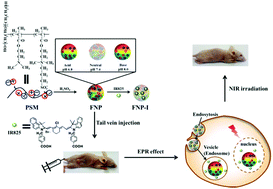Our official English website, www.x-mol.net, welcomes your
feedback! (Note: you will need to create a separate account there.)
pH-Responsible fluorescent carbon nanoparticles for tumor selective theranostics via pH-turn on/off fluorescence and photothermal effect in vivo and in vitro†
Nanoscale ( IF 5.8 ) Pub Date : 2017-12-27 00:00:00 , DOI: 10.1039/c7nr07900a Eun Bi Kang 1, 2, 3, 4 , Jung Eun Lee 4, 5, 6, 7 , Zihnil Adha Islamy Mazrad 2, 3, 4, 8 , Insik In 2, 3, 4, 8, 9 , Ji Hoon Jeong 4, 5, 6, 7 , Sung Young Park 1, 2, 3, 4, 8
Nanoscale ( IF 5.8 ) Pub Date : 2017-12-27 00:00:00 , DOI: 10.1039/c7nr07900a Eun Bi Kang 1, 2, 3, 4 , Jung Eun Lee 4, 5, 6, 7 , Zihnil Adha Islamy Mazrad 2, 3, 4, 8 , Insik In 2, 3, 4, 8, 9 , Ji Hoon Jeong 4, 5, 6, 7 , Sung Young Park 1, 2, 3, 4, 8
Affiliation

|
We developed nanoparticles comprising a photothermal dye (IR825)-loaded carbonized zwitterionic polymer [FNP-I] as “switch-on” pH-responsive fluorescence probes to sense intracellular cancer cells and for near-infrared (NIR) controllable photothermal therapy (PTT) in vivo and in vitro. The fluorescent “off” of FNP-I was activated after reaching the cancer cell environment, where the zwitterionic compartment of FNP lost its hydrophobicity to induce PTT-mediated heat release of IR825 under NIR irradiation in the tumor. Approximately 100% of the IR825 was released from the FNP core to generate high thermal conversion to completely kill the cancer cells. Furthermore, after intravenous treatment of FNP-I into MDAMB-231-cell bearing mice, pH-responsive photothermal therapy was observed, achieving marked ablation of tumor cells with release of IR825 under tumor environment conditions. In addition, fluorescent signals were clearly found at the tumor site after 3 h, decreasing at the 6 h time point. The in vitro and in vivo detection system demonstrated good cellular uptake and biocompatibility as a potential imaging-guided photothermal therapy nanotool for cancer treatment. Interestingly, the synergism of the biosensor and PTT in single FNP-I platform led to more effective cancer cell killing than either monotherapy, providing a new approach for cancer treatment.
中文翻译:

pH负责的荧光碳纳米颗粒,通过体内/体外的pH开启/关闭荧光和光热效应,可用于肿瘤选择性治疗学†
我们开发了包含载有光热染料(IR825)的碳化两性离子聚合物[FNP-I]的纳米颗粒,作为“开启” pH响应荧光探针,可感测细胞内癌细胞并用于近红外(NIR)可控的光热疗法(PTT)体内和体外。到达癌细胞环境后,FNP-1的荧光“关闭”被激活,在该环境中,FNP的两性离子区失去了疏水性,从而在肿瘤的NIR照射下诱导了PTT介导的IR825放热。IR825的大约100%从FNP核中释放出来,以产生高的热转化率,从而完全杀死癌细胞。此外,在将FNP-1静脉注射入带有MDAMB-231细胞的小鼠体内后,观察到pH响应的光热疗法,在肿瘤环境条件下通过释放IR825实现了肿瘤细胞的明显消融。另外,在3小时后在肿瘤部位清楚地发现荧光信号,在6小时时间点减少。在体外和体内检测系统显示出良好的细胞摄取和生物相容性,是一种潜在的以成像为导向的光热疗法纳米工具,可用于治疗癌症。有趣的是,单一FNP-1平台中生物传感器和PTT的协同作用比任何一种单一疗法都能更有效地杀死癌细胞,从而为癌症治疗提供了一种新方法。
更新日期:2017-12-27
中文翻译:

pH负责的荧光碳纳米颗粒,通过体内/体外的pH开启/关闭荧光和光热效应,可用于肿瘤选择性治疗学†
我们开发了包含载有光热染料(IR825)的碳化两性离子聚合物[FNP-I]的纳米颗粒,作为“开启” pH响应荧光探针,可感测细胞内癌细胞并用于近红外(NIR)可控的光热疗法(PTT)体内和体外。到达癌细胞环境后,FNP-1的荧光“关闭”被激活,在该环境中,FNP的两性离子区失去了疏水性,从而在肿瘤的NIR照射下诱导了PTT介导的IR825放热。IR825的大约100%从FNP核中释放出来,以产生高的热转化率,从而完全杀死癌细胞。此外,在将FNP-1静脉注射入带有MDAMB-231细胞的小鼠体内后,观察到pH响应的光热疗法,在肿瘤环境条件下通过释放IR825实现了肿瘤细胞的明显消融。另外,在3小时后在肿瘤部位清楚地发现荧光信号,在6小时时间点减少。在体外和体内检测系统显示出良好的细胞摄取和生物相容性,是一种潜在的以成像为导向的光热疗法纳米工具,可用于治疗癌症。有趣的是,单一FNP-1平台中生物传感器和PTT的协同作用比任何一种单一疗法都能更有效地杀死癌细胞,从而为癌症治疗提供了一种新方法。











































 京公网安备 11010802027423号
京公网安备 11010802027423号